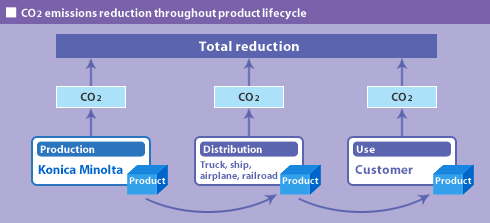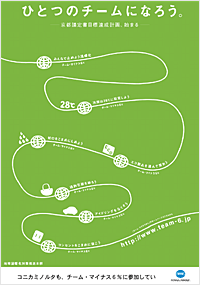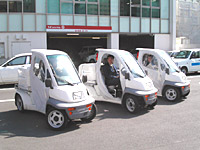Global Warming Prevention

Concept for Preventing Global Warming -- CO2 Reduction throughout Product Lifecycle --
Helping to prevent global warming is one of the most important social responsibilities of the manufacturer today. The Konica Minolta Group is committed to helping prevent global warming from an overall product lifecycle perspective.
Our measures for reducing CO2 emissions cover not only emissions from our business sites during product manufacture, but also during product distribution and use at the customer' s site.
Beginning in fiscal 2006, Konica Minolta is targeting a 20% reduction in CO2 emissions by fiscal 2010 (as compared to the 2000 level) throughout the product lifecycle, from production and distribution to use. To ensure that we achieve this goal, reduction targets are set, respectively, for the following three parameters: CO2 emissions from sites in Japan, from manufacturing sites outside Japan, and during product use.

Reduction of CO2 Emissions from Business Sites
In February 2005, the Kyoto Protocol took effect. Corporate responsibility for reducing CO2 emissions from business sites has increased accordingly. Konica Minolta is working to achieve its ambitious target, “7% reduction of CO2 emissions from Group business sites in Japan by fiscal 2010, as compared to fiscal 1990 levels.” Our target of 7% reduction in CO2 emissions is higher than the target Japan must meet under the Kyoto Protocol. Beginning in fiscal 2006, the Company also established another target, “7% reduction of CO2 emissions from Group manufacturing sites outside Japan by fiscal 2010, as compared to fiscal 2000 levels,” so as to globally redouble our energy-saving efforts.
In fiscal 2005, CO2 emissions from Group business sites in Japan increased by 1.5% as compared to the previous year (23.6% increase from 1990 levels). This occurred because the rise in energy consumption due to increased production of TAC film for LCDs exceeded the reduction in CO2 emissions achieved though our energy-saving activities. Each Konica Minolta business site works to reduce CO2 emissions by making physical improvements to utility systems, such as by replacing facilities and equipment with inverter-driven equivalents, introducing high-efficiency equipment, and converting fuel from heavy oil to natural gas. At the same time, respective business sites have strengthened their measures for preventing excessive air leakage and for improving production efficiency, so as to reduce CO2 emissions during production. Through these efforts we have reduced CO2 emissions by approximately 3,000 tons. Konica Minolta has also implemented an Energy-Conservation Support Program at business sites that release large amounts of CO2, so as to comprehensively assess the energy use at each site and identify energy-saving measures appropriate to each site. Under the Program, we have come up with some 500 measures for energy conservation. Through use of these measures, we expect that Konica Minolta can reduce CO2 emissions by approximately 30,000 tons by fiscal 2010. Meanwhile, CO2 emissions from manufacturing sites outside Japan increased by 10% compared to the previous year (21.6% increase from fiscal 2000 levels).
We understand that our future plans for plant expansion and production expansion involve many factors that could increase CO2 emissions. To cover such increase, Konica Minolta has made preparations for acquiring emission credits - as a complementary measure - in conjunction with thoroughgoing energy-saving efforts. In fiscal 2005, the Company developed a program for emission credit assessment, based on which we select appropriate projects that can contribute to global environmental protection and are suitable for Konica Minolta' s characteristics.
From this time forward we will disseminate successful energy-saving practices and implement measures to address the points shown by the Energy Conservation Support Program to require improvement, not only throughout Japan but also overseas. We will continue our all-out efforts toward energy-saving, complemented by initiatives for emission credit acquisition.

Conversion from Gas Cogeneration to Power Purchase
At our Tokyo Hino Site (Hino City, Tokyo), we stopped using a 14,000 kW capacity gas turbine cogeneration system for in-house power generation at the end of March 2006. Instead, we began to use electricity purchased from a power company. This changeover was based on our judgment that purchasing power is more advantageous than using the gas cogeneration system, in terms of CO2 reduction and cost performance.
The Hino Site, Konica Minolta' s largest plant in Japan, commenced using cogeneration system #1 in 1986. The Site then introduced gas turbine cogeneration system #2 (generating capacity: 7,000 kW, steam flow: 30 t/h) in 1998. In 2004, 90% of the plant' s electricity requirement was met by these gas turbine cogeneration systems, with resultant steam used for refrigeration, air blowers used in the production process, and general heat sources. Of these two cogeneration systems, we terminated operation of system #1 and began to use purchased electricity instead. With the service life of system #1 close to expiration, we deemed it better, in terms of environmental performance and cost-effectiveness, to purchase electricity from a power company rather than to update the existing system. We estimate that this changeover will enable us to reduce CO2 emissions by 4,000 tons annually.
Team Minus 6%
“Team Minus 6%” is the nickname of a national campaign waged in Japan to fight global warming by achieving the 6% reduction commitment stipulated in the Kyoto Protocol. In support of the campaign' s objective, Konica Minolta has enrolled as a member of “Team Minus 6%” and is taking the following measures.

- 1) In-house measures
-
- Recommended air conditioning settings of 28 degrees C in summer, and 20 degrees C in winter
- Putting up posters to advertise Company participation in “Team Minus 6%” to all employees and call for their all-out efforts
- Promoting “Cool Biz” and “Warm Biz” campaigns to encourage employees to dress down in summer and dress warmly in winter, so as to adapt to appropriate room temperature settings.
- Efficient operation of elevators
- “Two-up and Three-down” campaign (use stairs, rather than elevators, when going up two floors and down three floors)
- Energy-saving on office lighting and OA equipment
- Turning off unnecessary lights
- Using energy-saving mode and turning off OA equipment when not needed
- Promotion of idling stops
- Stopping engine idling in Company-owned vehicles when not in motion
- Requesting vehicles entering Company premises to stop idling engines when not in motion
- Recommended air conditioning settings of 28 degrees C in summer, and 20 degrees C in winter
- 2) Activities at home
- Promoting employees to act on the “Team Minus 6%” campaign even at home
- 3) Activities outside the Company
- Encouraging (mainly via the Public Relations Department) active participation in related campaigns and other events organized outside the Company
Reduction of CO2 Emissions during Product Distribution
The Konica Minolta Group is promoting a modal shift away from long-distance trucking to transport by rail and sea. In Japan we have been using rail or sea for long- and mid-distance transportation of our products, such as photographic paper and films.
Furthermore, we have been working to improve our logistical efficiency through distribution center integration, joint transportation between distribution centers, and use of the return journey from product delivery to collect used copiers and photographic developer equipment.
Reduction Efforts during the Sales Stage
Konica Minolta Business Solutions Japan has introduced three electric-powered vehicles. Service engineers use these vehicles when visiting customers for maintenance of multifunctional peripherals (MFPs) and other equipment. Electric vehicles have less environmental impact and their compact bodies afford better mobility in urban areas. We will therefore continue to increase the number of business sites using this type of vehicle.


